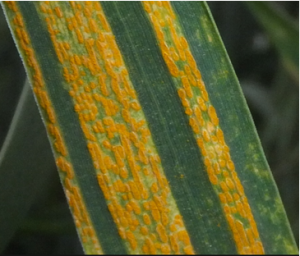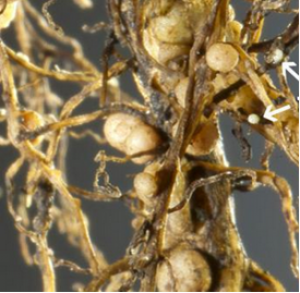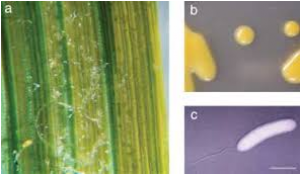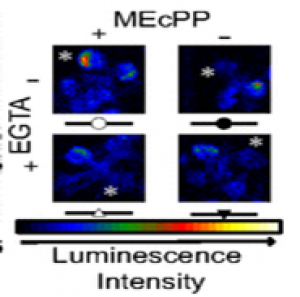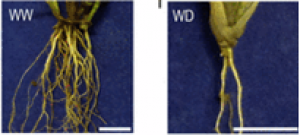Virulence shifts in populations of Puccinia striiformis f. sp. tritici (Pst), the causal pathogen of wheat stripe rust, are a major challenge to resistance breeding. The majority of known resistance genes are already ineffective against current races of Pst, necessitating the identification and introgression of new sources of resistance. Germplasm core collections that reflect the range of genetic and phenotypic diversity of crop species are ideal platforms for examining the genetic architecture of complex traits such as resistance to stripe rust
Cassava plants (Manihot esculenta Crantz) have obvious abscission zone (AZ) structures in their leaf pulvinus-petioles. Cassava leaf abscission can be triggered by either 17 days of water-deficit stress or 4 days of ethylene treatment. To date, little is known about cassava AP2/ERF factors, and less is known regarding their roles in regulating abscission zone development.
A major soybean (Forrest cultivar) quantitative trait locus (QTL) gene, Rhg4, which controls resistance to soybean cyst nematodes (SCN), encodes the enzyme serine hydroxylmethyltransferase (SHMT). The resistant allele possesses two critical missense mutations (P130R and N358Y) compared to that of the sensitive allele, rhg4. To understand the evolutionary history of this gene, sequences of 117 SHMT family members from 18 representative plant species were used to reconstruct their phylogeny.
Homologs of the LuxR acyl-homoserine lactone (AHL) quorum-sensing signal receptor are prevalent in Proteobacteria isolated from roots of the Eastern cottonwood tree, Populus deltoides. Many of these isolates possess an orphan LuxR homolog, closely related to OryR from the rice pathogen Xanthomonas oryzae OryR does not respond to AHL signals but, instead, responds to an unknown plant compound. We discovered an OryR homolog, PipR, in the cottonwood endophyte Pseudomonas sp. strain GM79.
Molecular characterization of sequence flanking exogenous fragment insertion is essential for safety assessment and labeling of genetically modified organism (GMO). In this study, the T-DNA insertion sites and flanking sequences were identified in two newly developed transgenic glyphosate-tolerant soybeans GE-J16 and ZH10-6 based on whole genome sequencing (WGS) method. More than 22.4 Gb sequence data (∼21 × coverage) for each line was generated on Illumina HiSeq 2500 platform.
Stress associated proteins (SAPs) are the A20/AN1 zinc-finger containing proteins which can regulate the stress signaling in plants. The rice SAP protein, OsSAP1 has been shown to confer abiotic stress tolerance to plants, when overexpressed, by modulating the expression of endogenous stress-related genes. To further understand the mechanism of OsSAP1-mediated stress signaling, OsSAP1 interacting proteins were identified using yeast two-hybrid analysis. Two novel proteins, aminotransferase (OsAMTR1) and a SCP/TAPS or pathogenesis-related 1 class of protein (OsSCP) were found to interact with OsSAP1.
A dual-function plastidial metabolite, methylerythritol cyclodiphosphate (MEcPP), an intermediate of the plastidial pathway for isoprenoids production and a retrograde signaling metabolite, transduces signals to activate general stress-response (GSR) genes by inducing a transcriptionally centered stress hub.
Grasses, whose members constitute key food and bioenergy crops worldwide, use unique developmental programs to establish the root system from the shoot. Shoot-borne crown roots originate near the soil surface and provide the main conduits through which the plant takes up water and nutrients. We show that crown root development is the major target of drought stress signaling.
Management of oxidative stress in plant chloroplasts involves signaling pathways to the nucleus that trigger stress response mechanisms. Yet, how oxidative stress is initially sensed in the chloroplast to activate accumulation of a stress signal remains enigmatic. We show that inactivation of a phosphatase, SAL1, by oxidative stress in chloroplasts controls accumulation of its substrate, as a plant stress signal.
Late embryogenesis abundant (LEA) proteins are a family of small highly hydrophilic proteins that accumulate at the onset of seed desiccation and in response to adverse conditions such as drought, salinity, low temperature, or water deficit. In previous studies, we demonstrated that ZmLEA3 could enhance the transgenic tobacco tolerance to osmotic and oxidative stresses.


 Curently online :
Curently online :
 Total visitors :
Total visitors :
